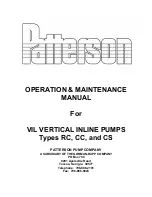
Installation manual
20
0 EKCBX/H008BAV3
Unit for air to water heat pump system
4PW64602-1A – 09.2010
10.5. Protecting the water circuit against freezing
Frost can damage the unit. As this unit is installed outdoors and thus
the hydraulic system is exposed to freezing temperatures, care must
be taken to prevent freezing of the system. All hydraulic parts are
insulated to reduce heat loss. Insulation must be foreseen on the field
piping.
The unit is already equipped with several features to prevent freezing.
■
The software contains special functions using pump and back
up heater to protect the complete system against freezing. This
function will only be active when the unit is off.
However in case of power failure, above mentioned features can
not protect the unit from freezing.
If power failure can happen at times the unit is unattended,
Daikin recommends adding glycol to the water system. Refer to
Caution: "Corrosion of the system due to presence of glycol" on
page 20
Refer to "[4-04] Freeze protection function" on page 33.
Depending on the expected lowest outdoor temperature, make
sure the water system is filled with a weight concentration of
glycol as mentioned in the table below.
Also refer to "Pre-run checks" on page 42.
NOTICE
■
The unit is only to be used in a closed water system.
Application in an open water circuit can lead to
excessive corrosion of the water piping.
■
Never use Zn-coated parts in the water circuit.
Excessive corrosion of these parts may occur as
copper piping is used in the unit's internal water
circuit.
■
When using a 3-way valve in the water circuit.
Preferably choose a ball type 3-way valve to
guarantee full separation between domestic hot water
and floor heating water circuit.
■
When using a 3-way valve or a 2-way valve in the
water circuit. The recommended maximum
changeover time of the valve should be less than 60
seconds.
Minimum outdoor
temperature
Glycol (a)(b)(c)
–5°C
10%
–10°C
15%
–15°C
20%
–20°C
25%
–25°C
30%
WARNING
(a)
ETHYLENE GLYCOL IS TOXIC
(b)
The concentrations mentioned in the table
above will not prevent the medium from
freezing, but prevent the hydraulics from
bursting.
(c)
The maximum allowed water volume is then
reduced according to the figure "Checking the
maximum allowed water volume" on page 19
CAUTION
■
For installations with a domestic hot water tank,
the use of propylene glycol, including necessary
inhibitors, is only allowed if classified as
Category 3 according to EN1717 or equivalent
based on national regulations.
■
In case of over-pressure when using glycol, be
sure to connect the safety valve to a drain pan in
order to recover the glycol.
Connecting a drain pipe is not required if no
glycol is used. The discharged water is then
drained via the bottom of the unit.
CAUTION
Corrosion of the system due to presence of glycol
Uninhibited glycol will turn acidic under the influence of
oxygen. This process is accelerated by presence of copper
and at higher temperatures. The acidic uninhibited glycol
attacks metal surfaces and forms galvanic corrosion cells
that cause severe damage to the system.
It is therefore of extreme importance:
■
that the water treatment is correctly executed by a
qualified water specialist;
■
that a glycol with corrosion inhibitors is selected to
counteract acids formed by the oxidation of glycols;
■
that in case of an installation with a domestic hot
water tank, only the use of propylene glycol, including
necessary inhibitors classified as Category 3
according to EN1717 or equivalent based on the
applicable legislation is allowed. In other installations
the use of ethylene glycol is permitted as well;
■
that no automotive glycol is used because their
corrosion inhibitors have a limited lifetime and contain
silicates which can foul or plug the system;
■
that galvanized piping is not used in glycol systems
since its presence may lead to the precipitation of
certain components in the glycolís corrosion inhibitor;
■
that it has to be made sure the glycol is compatible
with the used materials in the system.
NOTICE
Be aware of the hygroscopic property of glycol: it absorbs
moisture from its environment.
Leaving the cap off the glycol container causes the
concentration of water to increase. The glycol
concentration is then lower than assumed. And in
consequence, freezing can happen after all.
Preventive actions must be taken to ensure minimal
exposure of the glycol to air.
4PW64602-1A.book Page 20 Thursday, September 23, 2010 10:40 AM
















































